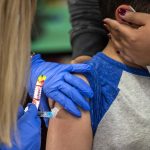Evers Wants State Health “Lead Czar”
Also supports bill to provide $40 million in loans for home owners to replace lead laterals.
Stymied in his efforts to set aside an extra $40 million in the state budget for lead abatement, Wisconsin Gov. Tony Evers on Monday signed an executive order directing the state’s Department of Health Services to name a “lead czar” charged with working across multiple state agencies “to ensure a robust and comprehensive response” to lead poisoning threats across the state.
Evers also said he would support a stand-alone bill now being circulated to gain cosponsors that would using bonding authority to enable up to $40 million in loans to private property owners to help pay for replacing lead service lines — the same amount of money that Republican legislators cut from Evers’ budget for the same purpose.
In signing the order, the governor renewed his criticism of the legislature for those cuts.
“The good news is that lead exposure can obviously be prevented,” Evers said. “The bad news is that the legislature did not do well enough in the budget to fund our effort to tackle this crisis. Since the legislature failed to properly fund this effort, I’ll do everything within my power as governor to protect Wisconsin’s children.”
Raising lead hazard’s profile
The executive order Evers signed Monday doesn’t appropriate any additional funds — something that would be beyond the governor’s power. But it aims to raise the profile of the hazard lead exposure poses and make the most of the $32.65 million that the state budgeted for improving water quality in general around the state.
“These investments are important, but they do not go far enough to address the serious issues impacting our community,” Evers said. “It’s only a down payment on the work that needs to be done. There are still more than 176,000 lead service lines providing contaminated drinking water to homes, schools and businesses across Wisconsin. This is a critical issue.”
Evers signed the order shortly after noon at a Kenosha day care center, where he was surrounded by two dozen preschool children. The setting drove home a central theme that he and other speakers at the event raised: the hazard lead poisoning presents especially to children, who might be exposed to the heavy metal from drinking water that passes through decaying pipes and from lead-based paint used in buildings until it was banned in 1978.
4,000 kids a year
According to the Department of Health Services, since 1996 more than 200,000 children in Wisconsin have been identified as having dangerous lead levels in their body. Jeanne Ayers, the state health officer and administrator of the Division of Public Health at the DHS, observed that childhood lead poisoning “still affects 4,000 children each year.”
It also imposes costs on society through higher medical costs, the increased need for special education, increased high school dropout rates and increased juvenile criminal activity, she added.
“It’s a silent disease which can rob children of their future potential without producing any clear signs or symptoms of its presence,” Ayers said.
People of color are among the most seriously affected, said Lt. Gov. Mandela Barnes. “In the city of Milwaukee alone, nearly 11% of the children tested were found to have lead poisoning, a higher percentage than any city in our state,” he said.
Kenosha is among the top five Wisconsin cities for lead exposure, Barnes added.
Statewide problem
At the same time, Evers noted that it’s not just an urban issue. “Lead poisoning is a statewide risk, not just in Kenosha, Milwaukee or other communities across the state. The Department of Health Services has identified that lead poisoning exists in every county in Wisconsin.”
Besides directing the state DHS to name a staffer to coordinate lead-poisoning prevention in the state, the order directs “all cabinet agencies, under the leadership of the Department of Health Services’ designated lead coordinator, to use their respective areas of expertise to address Wisconsin’s lead crisis through a multi-pronged approach.”
It also directs DHS to provide “all necessary staffing and resources” to help other state departments collaborate and work with local health departments and community groups “to accelerate more robust lead prevention, treatment, removal, abatement, and surveillance efforts.”
In a brief question-and-answer session after the signing, Evers was asked whether he would support a bill, now circulating in draft form for cosponsors, that would increase the state Safe Drinking Water Loan Program’s bonding authority by $40 million. The measure, authored by Sen. LaTonya Johnson (D-Milwaukee), would require that the additional funds be allocated to cover forgivable loans to private users of public water systems, paying for up to half the cost of replacing lead service lines.
“I support that,” Evers replied. “I encourage the people of Wisconsin to let our legislators know that the time is now.”
Reprinted with permission of Wisconsin Examiner.
More about the Lead Crisis
- $43 Million Later, MPS Says Classrooms Are Safe From Lead Dust - Corrinne Hess - Dec 18th, 2025
- MPS Buildings Cleared of Lead-Paint Risks after 10-Plus Months of Work - Milwaukee Public Schools - Dec 17th, 2025
- Wisconsin Moves to Require Lead Service Lines Replaced By 2037 - Danielle Kaeding - Dec 11th, 2025
- Gov. Evers, DNR Announce More Than $159 Million to Ensure Clean, Safe Drinking Water for Wisconsinites in 29 Municipalities - Gov. Tony Evers - Dec 10th, 2025
- EPA Announces $3 Billion in New Funding for States to Reduce Lead in Drinking Water - U.S. Environmental Protection Agency - Nov 25th, 2025
- Wisconsin Communities Get $282 Million for Drinking Water Projects - Danielle Kaeding - Nov 19th, 2025
- MKE County: County Launches Lead Abatement Program - Graham Kilmer - Nov 9th, 2025
- Milwaukee County Launches Lead Remediation Program to Reduce Lead-Based Paint Hazards in Homes in Suburban Communities - David Crowley - Nov 5th, 2025
- Wisconsin Improves Child Lead Testing Rates, Urges Continued Testing and At-Home Prevention - Wisconsin Department of Health Services - Oct 21st, 2025
- City Hall: Milwaukee Must Replace 100 Lead Laterals Per Week To Meet 2025 Goal - Jeramey Jannene - Oct 1st, 2025
Read more about Lead Crisis here






















